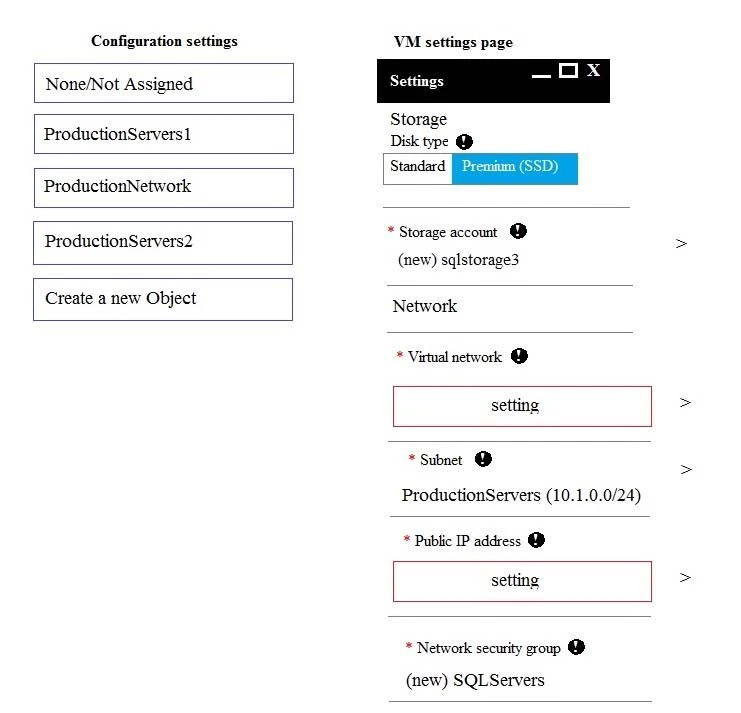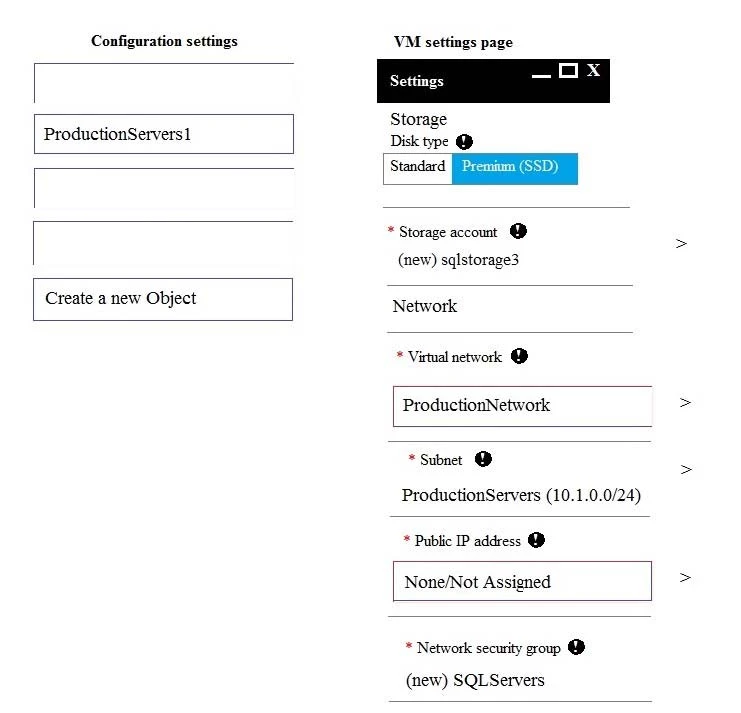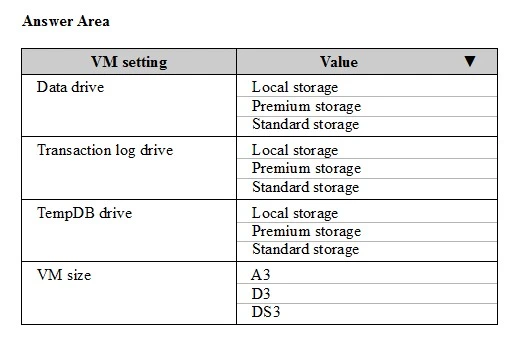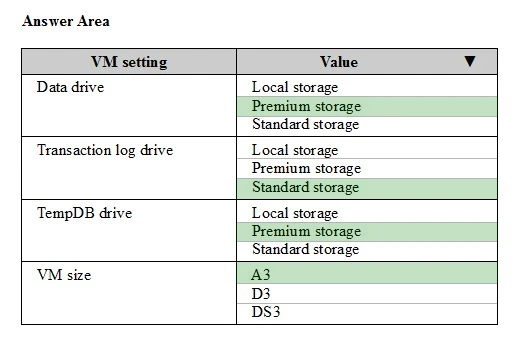Question 6 of 168
Note: This question is part of a series of questions that use the same or similar answer choices. An answer choice may be correct for more than one question in the series. Each question is independent of the other questions in this series. Information and details provided in a question apply only to that question.
You have deployed a GS-series virtual machine (VM) in Microsoft Azure. You plan to deploy Microsoft SQL Server.
You need to deploy a 30 megabyte (MB) database that requires 100 IOPS to be guaranteed while minimizing costs.
Which storage option should you use?
You have deployed a GS-series virtual machine (VM) in Microsoft Azure. You plan to deploy Microsoft SQL Server.
You need to deploy a 30 megabyte (MB) database that requires 100 IOPS to be guaranteed while minimizing costs.
Which storage option should you use?
Correct Answer: A
Premium Storage Disks Limits -
When you provision a disk against a Premium Storage account, how much input/output operations per second (IOPS) and throughput (bandwidth) it can get depends on the size of the disk. Currently, there are three types of Premium Storage disks: P10, P20, and P30. Each one has specific limits for IOPS and throughput as specified in the following table:

References:
https://docs.microsoft.com/en-us/azure/storage/storage-premium-storage A
When you provision a disk against a Premium Storage account, how much input/output operations per second (IOPS) and throughput (bandwidth) it can get depends on the size of the disk. Currently, there are three types of Premium Storage disks: P10, P20, and P30. Each one has specific limits for IOPS and throughput as specified in the following table:

References:
https://docs.microsoft.com/en-us/azure/storage/storage-premium-storage A
Question 7 of 168
Note: This question is part of a series of questions that use the same or similar answer choices. An answer choice may be correct for more than one question in the series. Each question is independent of the other questions in this series. Information and details provided in a question apply only to that question.
You have deployed several GS-series virtual machines (VMs) in Microsoft Azure. You plan to deploy Microsoft SQL Server in a development environment.
You need to provide storage to the environment that minimizes costs.
Which storage option should you use?
You have deployed several GS-series virtual machines (VMs) in Microsoft Azure. You plan to deploy Microsoft SQL Server in a development environment.
You need to provide storage to the environment that minimizes costs.
Which storage option should you use?
Correct Answer: D
Question 8 of 168
HOTSPOT -
You use Resource Manager to deploy a new Microsoft SQL Server instance in a Microsoft Azure virtual machine (VM) that uses Premium storage. The combined initial size of the SQL Server user database files is expected to be over 200 gigabytes (GB). You must maximize performance for the database files and the log file.
You add the following additional drive volumes to the VM:

You have the following requirements:
✑ Maximize performance of the SQL Server instance.
✑ Use Premium storage when possible.
You need to deploy the SQL instance.
In the table below, identify the drive where you must store each SQL Server file type.
NOTE: Make only one selection in each column. Each correct selection is worth one point.
Hot Area:
You use Resource Manager to deploy a new Microsoft SQL Server instance in a Microsoft Azure virtual machine (VM) that uses Premium storage. The combined initial size of the SQL Server user database files is expected to be over 200 gigabytes (GB). You must maximize performance for the database files and the log file.
You add the following additional drive volumes to the VM:

You have the following requirements:
✑ Maximize performance of the SQL Server instance.
✑ Use Premium storage when possible.
You need to deploy the SQL instance.
In the table below, identify the drive where you must store each SQL Server file type.
NOTE: Make only one selection in each column. Each correct selection is worth one point.
Hot Area:
Correct Answer:
Enable read caching on the disk(s) hosting the data files and TempDB.
Do not enable caching on disk(s) hosting the log file. Host caching is not used for log files.
Incorrect Answers:
C, D: Avoid using operating system or temporary disks for database storage or logging.
References:
https://docs.microsoft.com/en-us/azure/virtual-machines/windows/sql/virtual-machines-windows-sql-performance
Do not enable caching on disk(s) hosting the log file. Host caching is not used for log files.
Incorrect Answers:
C, D: Avoid using operating system or temporary disks for database storage or logging.
References:
https://docs.microsoft.com/en-us/azure/virtual-machines/windows/sql/virtual-machines-windows-sql-performance

Question 9 of 168
DRAG DROP -
You are building a new Always On Availability Group in Microsoft Azure. The corporate domain controllers (DCs) are attached to a virtual network named
ProductionNetwork. The DCs are part of an availability set named ProductionServers1.
You create the first node of the availability group and add it to an availability set named ProductionServers2. The availability group node is a virtual machine (VM) that runs Microsoft SQL Server. You attach the node to ProductionNetwork.
The servers in the availability group must be directly accessible only by other company VMs in Azure.
You need to configure the second SQL Server VM for the availability group.
How should you configure the VM? To answer, drag the appropriate configuration settings to the correct target locations. Each configuration setting may be used once, more than once, or not at all. You may need to drag the split bar between panes or scroll to view content.
NOTE: Each correct selection is worth one point.
Select and Place:

You are building a new Always On Availability Group in Microsoft Azure. The corporate domain controllers (DCs) are attached to a virtual network named
ProductionNetwork. The DCs are part of an availability set named ProductionServers1.
You create the first node of the availability group and add it to an availability set named ProductionServers2. The availability group node is a virtual machine (VM) that runs Microsoft SQL Server. You attach the node to ProductionNetwork.
The servers in the availability group must be directly accessible only by other company VMs in Azure.
You need to configure the second SQL Server VM for the availability group.
How should you configure the VM? To answer, drag the appropriate configuration settings to the correct target locations. Each configuration setting may be used once, more than once, or not at all. You may need to drag the split bar between panes or scroll to view content.
NOTE: Each correct selection is worth one point.
Select and Place:

Correct Answer:
Explanation;
Box 1: ProductionNetwork -
The virtual network is named ProductionNetwork.
Box 2: None /Not Assigned -
As the servers in the availability group must be directly accessible only by other company VMs in Azure, there should be no Public IP address.
Box 3: ProductionServer2 -
You create the first node of the availability group and add it to an availability set named ProductionServers2. The availability group node is a virtual machine (VM) that runs Microsoft SQL Server.
Box 1: ProductionNetwork -
The virtual network is named ProductionNetwork.
Box 2: None /Not Assigned -
As the servers in the availability group must be directly accessible only by other company VMs in Azure, there should be no Public IP address.
Box 3: ProductionServer2 -
You create the first node of the availability group and add it to an availability set named ProductionServers2. The availability group node is a virtual machine (VM) that runs Microsoft SQL Server.

Question 10 of 168
HOTSPOT -
You plan to migrate a Microsoft SQL Server workload from an on-premises server to a Microsoft Azure virtual machine (VM). The current server contains 4 cores with an average CPU workload of 6 percent and a peak workload of 10 percent when using 2.4Ghz processors.
You gather the following metrics:

You need to design a SQL Server VM to support the migration while minimizing costs.
For each setting, which value should you use? To answer, select the appropriate storage option from each list in the answer area.
NOTE: Each correct selection is worth one point.
Hot Area:

You plan to migrate a Microsoft SQL Server workload from an on-premises server to a Microsoft Azure virtual machine (VM). The current server contains 4 cores with an average CPU workload of 6 percent and a peak workload of 10 percent when using 2.4Ghz processors.
You gather the following metrics:

You need to design a SQL Server VM to support the migration while minimizing costs.
For each setting, which value should you use? To answer, select the appropriate storage option from each list in the answer area.
NOTE: Each correct selection is worth one point.
Hot Area:

Correct Answer:
Data drive: Premium Storage -
Transaction log drive: Standard Storage
TempDB drive: Premium Storage -
Note: A standard disk is expected to handle 500 IOPS or 60MB/s.
A P10 Premium disk is expected to handle 500 IOPS.
A P20 Premium disk is expected to handle 2300 IOPS.
A P30 Premium disk is expected to handle 5000 IOPS.
VM size: A3 -
Max data disk throughput is 8x500 IOPS
References:
https://docs.microsoft.com/en-us/azure/virtual-machines/virtual-machines-windows-sizes
Transaction log drive: Standard Storage
TempDB drive: Premium Storage -
Note: A standard disk is expected to handle 500 IOPS or 60MB/s.
A P10 Premium disk is expected to handle 500 IOPS.
A P20 Premium disk is expected to handle 2300 IOPS.
A P30 Premium disk is expected to handle 5000 IOPS.
VM size: A3 -
Max data disk throughput is 8x500 IOPS
References:
https://docs.microsoft.com/en-us/azure/virtual-machines/virtual-machines-windows-sizes
